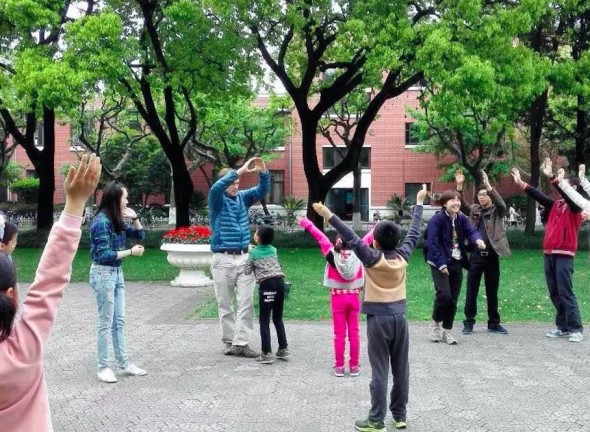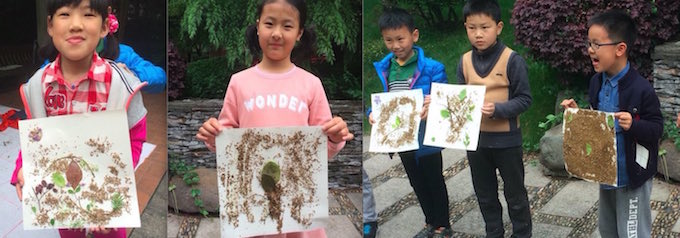 “Seeing Cinnamomum” is workshop series and book compilation that is part of the “Book of Leaves” program. The second family workshop was held this past weekend, during which participants created collages from ground camphor leaves and other detritus from the park. Not surprisingly several kids ignored instructions and went about creating artworks their own way. Joyfully piling on heaps of material one boy created what at first looked like an undifferentiated mess. “Very nice,” I said, “what does it mean?” A pause and then a shrug: “I dunno.”
“Seeing Cinnamomum” is workshop series and book compilation that is part of the “Book of Leaves” program. The second family workshop was held this past weekend, during which participants created collages from ground camphor leaves and other detritus from the park. Not surprisingly several kids ignored instructions and went about creating artworks their own way. Joyfully piling on heaps of material one boy created what at first looked like an undifferentiated mess. “Very nice,” I said, “what does it mean?” A pause and then a shrug: “I dunno.”
Artists engaged in field projects sometimes experience a sinking feeling that they are failing to connect. This sense is usually short lived, displaced by absorption in strategies to correct and the continuous barrage of other stimuli. Nonetheless the momentary cloud signifies a range of risks which underlie any improvisational art. Are these risks actually meaningful? If so what is the reward that justifies them?
 First let’s consider artists as agents of social transformation in the broadest sense, i.e. affecting the course of human evolution. “Double entrepreneurship” is a helpful term to understand how artists work in this respect, situating the artist in relation to his or her own inner circle of colleagues on the one hand (e.g. fellow artists, established audiences and affiliated arts institutions), and in relation to groups who are outside this circle on the other. Like entrepreneurs who entice groups of people into new ways of interacting with the world, artists entice us to new experiences that may influence cultural conventions. They are conceived as “double entrepreneurs” because they look for opportunities to exert influence in two directions: on the “external” participants in their practice and on their “internal” support base.
First let’s consider artists as agents of social transformation in the broadest sense, i.e. affecting the course of human evolution. “Double entrepreneurship” is a helpful term to understand how artists work in this respect, situating the artist in relation to his or her own inner circle of colleagues on the one hand (e.g. fellow artists, established audiences and affiliated arts institutions), and in relation to groups who are outside this circle on the other. Like entrepreneurs who entice groups of people into new ways of interacting with the world, artists entice us to new experiences that may influence cultural conventions. They are conceived as “double entrepreneurs” because they look for opportunities to exert influence in two directions: on the “external” participants in their practice and on their “internal” support base.
To activate social transformation, artists must simultaneously play on the conventions of their own “internal” culture as they play on those of the other “external” culture. In so doing they coax the emergence of something new. The conceptual simplicity of “double entrepreneurship” belies the difficulty of this working plan. Indeed, all artists fail at this to some degree, becoming either marginalized from art circles (cast for example as a social worker) and thereby losing legitimacy as “good artists”, or becoming marginal and irrelevant to “external” social groups as a result of adherence to complex art world conventions (e.g. a classical ballerina-in-training), or simply failing to entice anyone at all (e.g. the “crazy eccentric”). In the first two cases the artist provides services that presumably are valued to at least one group, but fails to live up to his/her full potential as an artist. The third case is a more conventional kind of career flop.
The personal risks are apparent: a great amount of planning and care goes into an art practice. The social risks may be best understood in terms of lost opportunities: lost opportunities to reconcile one culture to another, or the human sphere to the natural sphere. Artists are not saviors of the world— the responsibility for mending broken families, averting violent conflict or nurturing ecological integrity does not rest squarely on the shoulders of those who identify themselves as artists. Artists can have an influence in all these areas however, and the cost to society of their failure is indeed significant (albeit notoriously hard to calibrate).
 Opportunities for artists to work productively arise partly by chance and partly through a balanced alchemy of personalities, social context, material resources, environment, and political setting. Given the potential social costs and risk of failure, how can we best cultivate a world where artists are more likely to succeed? A beautiful starting point is to embrace the notion that we are all artists. Acknowledging and honoring the artist within us opens a line of communication to artists all around us by which opportunities to work together productively may flourish.
Opportunities for artists to work productively arise partly by chance and partly through a balanced alchemy of personalities, social context, material resources, environment, and political setting. Given the potential social costs and risk of failure, how can we best cultivate a world where artists are more likely to succeed? A beautiful starting point is to embrace the notion that we are all artists. Acknowledging and honoring the artist within us opens a line of communication to artists all around us by which opportunities to work together productively may flourish.
Returning to the scene in the park where the collage artworks are gradually taking form, the undifferentiated mess is now looking to me quite palpably like a forest floor. The adults (parents, myself, Shi Xiang, as well as several student and teacher observers from Roots and Shoots) are alternately crouching down to push leaf debris and twigs around and leaning back to observe the irregular proceedings. The kids are absorbed in the wonderful artifacts of nature and their own gestures, not much concerned with their origins or effects, but nonetheless driven by a purpose. The whole scene shimmers with an indistinct but happy kind of promise, borne of the potency of the artist abiding cautiously in us all!